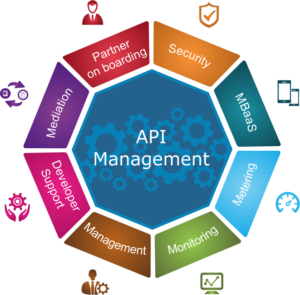API Management
- July 5, 2019
- Posted by: Rahul Thachilath
- Categories:
API management is the process of creating and publishing web APIs, enforcing their usage policies, controlling access, nurturing the subscriber community, collecting and analyzing usage statistics, and reporting on performance. API Management components provide mechanisms and tools to support developer and subscriber community.
The scope of API Management includes:
- The process of publishing, promoting, and overseeing APIs in a secure, scalable environment
- Ensuring that developers and partners are productive
- Managing, securing, and mediating your API traffic
- Allowing an organization to grow their API program to meet increasing demands
- Enabling the monetization of APIs
- The intersection of technology, business, organization, and integration concerns
An effective API Management solution manages the use of APIs to open up an organization or a system’s data so that it can be utilized by other parts of the organization or possibly third-party organizations in new and useful ways. A for-profit organization would use these capabilities to either create new revenue streams of revenue or enhance/optimize existing revenue streams (monetizing APIs); a non-profit organization or government organization may be trying to cover its operational costs while fulfilling its mission to provide benefit (in this case, in the form of data/information) to the public. API Management should provide an easy, effective, and efficient experience for the development community that is supposed to be using those APIs. API Management also provides a governance and life-cycle framework for APIs.
From a business perspective, API Management is a revolution; from a technical perspective, it is an evolution of the earlier Service Oriented Architecture (SOA) paradigm. While API management includes much more than the SOA concepts of the early 2000’s, those concepts are still present. If anything, API management is partly a response to the flaws in early SOA strategies.
Every API Management platform contains three components:
- API Gateway
- Developer Portal
- Management Portal
Every vendor has these parts — the names may differ. For the larger, more-established companies operating in this space, these pieces were probably built from existing components (for example, WebSphere DataPower acts as the API Gateway for IBM API Management).
API Governance is also part of API Management. In fact, it is probably the most important and the least exciting part of API Management — yet, it is likely the most often neglected. Governance is not a bad thing. In fact, for anything to be truly adopted by the enterprise, it must have adequate and functional governance. The key phrase there is “functional governance”. A gauge I have long used to determine whether a new technology, process, or thing is “functional” is whether it solves more problems than it creates. If the answer to that question is no or you’re not sure, rethink the approach.
API Governance addresses:
- tracking the life-cycle of each API from inception to sun-setting (more below)
- tracking the API Consumers and subscriptions (relationships)to APIs utilized
- the API Security Model employed and the details of managing it
- defines the API interface standards used for creating APIs (an organization’s standards for usage of something like Swagger) in the organization
- gathering statistics of both the Developer Portal and API Gateway usage
- utilization-based billing
- API versioning
- JSON (or XML) Schema versioning for input and output data structures
- tracking of routing information
API Governance must tie into:
- Change Management
- Asset Management
- Configuration Management
- Legacy SOA Governance (with the goal of eventually replacing it)
Each looks a little different in every organization. They likely are not managed by the same groups. There will be politics involved. One size does not fit all. Yet, all must be integrated.
API Life-Cycle Management (which tracks the interface’s life-cycle, not the implementation) is part of API Governance. The details will vary, but this basically describes the promotion process (life-cycle) of an API version from initial concept, to definition, to the lowest-level development environment, to production, and eventually to sun-setting. As an example, suppose your organization has the following environments:
- Unit Test Environment
- Quality Assurance Test Environment
- Load Test Environment
- Production Environment
Now, let’s assume that your API life-cycle captures the following additional steps:
- Inception (identification of a business or technical need)
- Definition (interface definition)
- Development
- Sun-setting
The API interface version’s life-cycle tracks these stages together with the deployment to each environment (listed above). For those who lived through SOA (especially with an overbearing SOA Governance paradigm), this should be starting to sound familiar with red flags and alarm bells. This started to become very cumbersome. There is also the question of how this ties into an Agile development methodology?
First, I am making an assumption that an interface-first design (or something in line with Apigee’s API First mantra) methodology in being followed. Meaning, you take the time to design the API interface and data structures before a single line of code has been written. This is like the top-down development methodology of SOAP Web Services. Next, I’m assuming that by the time Development and Unit Test deployment stages are hit, the interface is stable (yes, something always slips through the cracks). Next, I am assuming that the API Management Platform provides a self-service feature that allows for relatively painless transition to the next phase of the life-cycle; this deployment should be automated and allow for self-service. Whether this aspect of the API-side development process is managed through the Developer Portal, DevOps management tools, or something else depends on the implementation. There is a sweet spot for every organization regarding how elaborate this should be.
